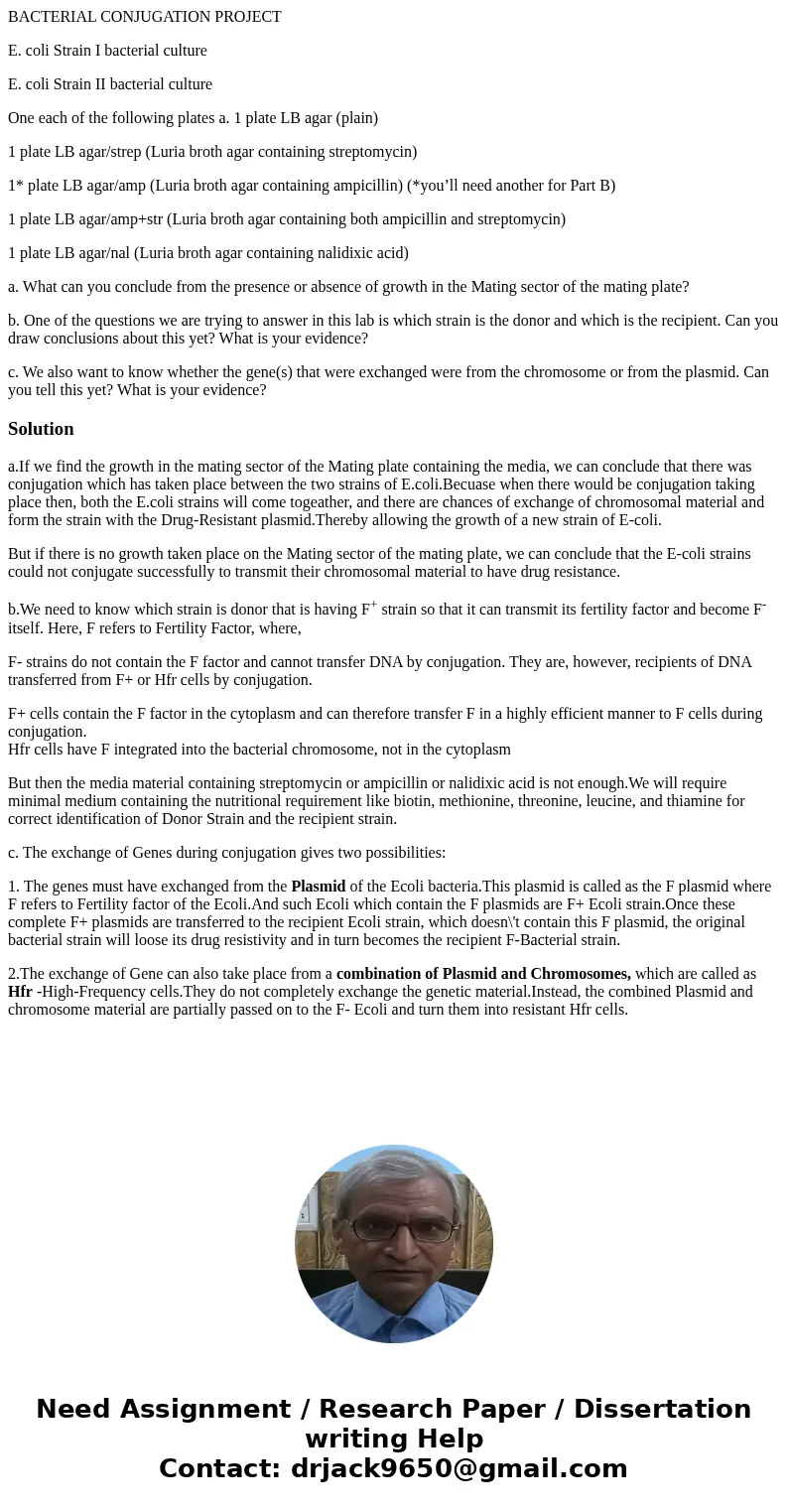BACTERIAL CONJUGATION PROJECT E coli Strain I bacterial cult
BACTERIAL CONJUGATION PROJECT
E. coli Strain I bacterial culture
E. coli Strain II bacterial culture
One each of the following plates a. 1 plate LB agar (plain)
1 plate LB agar/strep (Luria broth agar containing streptomycin)
1* plate LB agar/amp (Luria broth agar containing ampicillin) (*you’ll need another for Part B)
1 plate LB agar/amp+str (Luria broth agar containing both ampicillin and streptomycin)
1 plate LB agar/nal (Luria broth agar containing nalidixic acid)
a. What can you conclude from the presence or absence of growth in the Mating sector of the mating plate?
b. One of the questions we are trying to answer in this lab is which strain is the donor and which is the recipient. Can you draw conclusions about this yet? What is your evidence?
c. We also want to know whether the gene(s) that were exchanged were from the chromosome or from the plasmid. Can you tell this yet? What is your evidence?
Solution
a.If we find the growth in the mating sector of the Mating plate containing the media, we can conclude that there was conjugation which has taken place between the two strains of E.coli.Becuase when there would be conjugation taking place then, both the E.coli strains will come togeather, and there are chances of exchange of chromosomal material and form the strain with the Drug-Resistant plasmid.Thereby allowing the growth of a new strain of E-coli.
But if there is no growth taken place on the Mating sector of the mating plate, we can conclude that the E-coli strains could not conjugate successfully to transmit their chromosomal material to have drug resistance.
b.We need to know which strain is donor that is having F+ strain so that it can transmit its fertility factor and become F- itself. Here, F refers to Fertility Factor, where,
F- strains do not contain the F factor and cannot transfer DNA by conjugation. They are, however, recipients of DNA transferred from F+ or Hfr cells by conjugation.
F+ cells contain the F factor in the cytoplasm and can therefore transfer F in a highly efficient manner to F cells during conjugation.
Hfr cells have F integrated into the bacterial chromosome, not in the cytoplasm
But then the media material containing streptomycin or ampicillin or nalidixic acid is not enough.We will require minimal medium containing the nutritional requirement like biotin, methionine, threonine, leucine, and thiamine for correct identification of Donor Strain and the recipient strain.
c. The exchange of Genes during conjugation gives two possibilities:
1. The genes must have exchanged from the Plasmid of the Ecoli bacteria.This plasmid is called as the F plasmid where F refers to Fertility factor of the Ecoli.And such Ecoli which contain the F plasmids are F+ Ecoli strain.Once these complete F+ plasmids are transferred to the recipient Ecoli strain, which doesn\'t contain this F plasmid, the original bacterial strain will loose its drug resistivity and in turn becomes the recipient F-Bacterial strain.
2.The exchange of Gene can also take place from a combination of Plasmid and Chromosomes, which are called as Hfr -High-Frequency cells.They do not completely exchange the genetic material.Instead, the combined Plasmid and chromosome material are partially passed on to the F- Ecoli and turn them into resistant Hfr cells.

 Homework Sourse
Homework Sourse